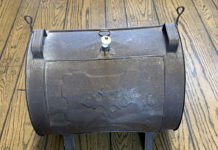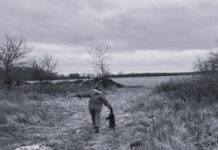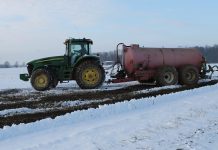When I was a kid, one of the things I learned on television was that, “It’s not nice to fool Mother Nature.” Apparently, however, it’s OK for Mother Nature to fool me.
Blue skies, sunshine and temperatures in the 50s put a smile on my face March 2 and 3. Robins, bluebirds, cardinals, chickadees and titmice were in full song, and the staccato beat of woodpecker drumming reverberated through the woods. Spring was in the air.
But when I left the house March 6, a few days later, an inch of snow covered the ground. It seemed a cruel joke, but then I noticed movement in the yard. Several dozen robins fed through the thin snow cover.
The ground was still thawed from the week’s earlier warm temperatures, and earthworms were near the surface. Hungry robins hopped from one wormhole to the next.
Spring messengers?
The appearance of robins in March does not necessarily mean they’ve returned from the south. Sometimes they’ve just returned from the deep woods. In either case, many people consider them harbingers of spring.
Though some robins migrate, many do not. Those that endure winter conditions spend most of the colder months deep in the woods eating fruits and berries. I can always find robins in January and February feeding on grapes, cherries and Virginia creeper berries.
Warmer temperatures and thawing turf draw them to open, earthworm-infested backyards. As weather permits, they shift their diet from fruits and berries to earthworms and other invertebrates.
Factors. Winter robin abundance is most influenced by two factors: snow cover and food availability. When snow cover is less than five inches, robins can handle winter. But heavier snow cover means colder temperatures and food that’s more difficult to find, so robins move south to more favorable conditions when snowfalls are heavy.
If food is abundant, robins can thrive in surprisingly cold temperatures. Fruit-bearing trees and shrubs such as cherries and grapes sustain robins during the winter months. Being dietary opportunists, robins remain where food is abundant until supplies are exhausted. Then they move on.
One reason robins may linger farther north, especially during mild winters, is the abundance of ornamental fruit trees in urban and suburban landscapes. We plant hawthorns, crab apples and hollies for their visual appeal, but robins value their fruits. Our horticultural habits have helped create a winter refuge for robins.
Short trip
Another advantage to less frequent and shorter migrations is that robins have that much less distance to travel in the spring. Thus they can return to their breeding territories earlier and in better condition.
Though people may see flocks of scores or even hundreds of robins during the day while they forage on fruits and berries, the largest and most impressive groups assemble just before dusk. Thousands, and sometimes tens of thousands, of robins roost in conifers or other dense cover.
They may be joined by cowbirds, grackles and starlings, also numbering in the thousands. Such a sight is impressive, unless you happen to park your car under a roost tree.
Large winter flocks of robins are typical in the southeastern and Gulf coast states, though serious birders can usually come up with a few winter robins just about anywhere. But large flocks of winter robins are always a sight to behold.
Just a few weeks ago in St. Petersburg, Fla., Great Backyard Bird Count participants reported more than 685,000 robins at one large roost. Even northern states such as Michigan (1,021) and New York (3,126) reported a surprising number of robins in the GBBC.
At dawn, these large roosting flocks break up into many smaller feeding flocks that might travel as far as 10 to 20 miles to a food source. At day’s end, they return to the roost for a good night’s sleep.
Alternative signs
Though many consider robins to be a sign of spring, there are better indicators. Blooming trilliums, trilling toads, yodeling wood thrushes and hyperactive hummingbirds are just a few of the harbingers I find more reliable.
(Send questions and comments to Dr. Scott Shalaway, RD 5, Cameron, WV 26033 or via e-mail at his website, http://scottshalaway.googlepages.com.)












